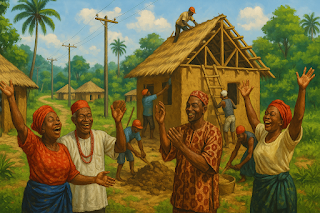By Maxwell Mbah
Ozu-ohia is not the name of a single community or town. It is an area or a large expanse of woodland inhabited by natives and settlers. They have been living side by side since history, on the fringes of Anambra and Enugu State of Nigeria.
They arrived there since antiquity and began to practise agriculture, and saw it as a dependable means of livelihood. Despite using traditional methods, farming was done extensively to produce food in commercial quantities. Farming rendered returns in leaps and bounds to those who were devoted to farm work. Families grew in their numbers and more hands were available for farm work, animal husbandry and palm oil production. Local markets, namely, Orie-Ozu and Afor Ugwuoba were usually flooded with potatoes, yams, garri, plantain, banana, including livestock, and poultry. Evacuation and Preservation became the problem, not food. With a litre of Premium Motor Spirit (PMS), selling for N1,200 (One thousand, two hundred naira), transportation costs placed food supplies out of the reach of most residents in Urban Centres.
A typical Afor day saw mini buses loaded beyond their capacity. Cages of Poultry and animals, including bunches of plantain and banana, were on the roof tops of buses. By the road side meat fat was dripping into the fire before a small of crowd of buyers. A meat seller, a young woman, looking as determined as ever, was attending to buyers.
“How is your business?” I asked.
“Fine Sir,” She responded.
“Very lucrative, I suppose?”
She broke into a smile, which I needed
“God is faithful”, She affirmed.
I picked a toothpick, collected a piece of hot meat and began to munch it.
I then paid, and left the spot.
Forest Reserve, before the recent road Construction began, was a hard road to travel, borrowing from Jimmy Cliff, a well-known Reggae Star. In the dry season, the earth road was filled with sand. Both car drivers and motorcycle operators racing through the jungle had stories of discomfort to tell. One’s car engine must be in perfect condition. Car tyres, too, must be good enough to grip the earth. Broken down vehicles often caused obstruction and delays. Once the road was free, a determined car driver or motorcycle operator, could cross the sandy road without experiencing engine failure. Crossing that segment of loose sand was regarded as a feat.
The greater part of the terrain was covered with a dense canopy of gmelina and Iroko trees. Forest guards were always on patrol to counter the activities of illegal tree cutters or loggers.
The following day, I headed back to Awka, after boarding a commercial bus at Ufuma Junction. It was a distance of about forty-five kilometres. It was a longer journey than merely visiting the Ozuh Community. I took a position at the back seat and fished out my jotter, checked through it before putting a call through to a friend of mine and University teacher, Professor S. Obikeze.
“Hello Prof,” I hailed him
“Hello, Max,” he responded.
After some initial pleasantries, I broached the issue.
“Do you think rural communities will be adversely affected by the development coming their way?”
“Max, I don’t think so. Firstly, it is development, not underdevelopment. Its hallmarks include good roads, electricity, housing estates etc.
“As you can see, housing estates are coming up, as in urban centres they are likely to attract crime and criminality. Examples are robberies, killings and some other vices. But these will be checkmated by security measures. Lives and property will be protected by government of the day. But tradition will certainly be overtaken by modernity.”
“Thank you, Prof.”
“You’re welcome.”
This is volume 2 of Communitariat.
Drop us a line or call us on 08034355767, about your community. Email address: theacademia4@gmail.com


